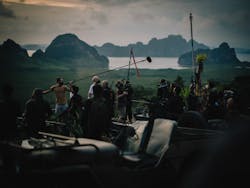The Creator (2023): How Did They Make the Best-Looking Film on the Cheapest Budget?
What you’ll learn
- How The Creator (2023) was made on a low budget.
- Whether AI was used to make a film about AI.
- More of "what did I think of it."
The Creator was made on a budget of $86 million, but it looks like it should have been $300 million. How did they do it?
I had a chance to speak with Jay Cooper, the visual effects supervisor at Industrial Light and Magic (ILM), to get to the bottom of how it was done via some behind-the-scenes info.
It’s hard not to feel the freshness wash over you while watching The Creator. Most films in the sci-fi genre employ lots of polished computer graphics (CG) that feel uncanny. With The Creator, that freshness I speak of comes from the world feeling real—because the fact of the matter is, it was. Real places, real things.
Jay explained how the director, Gareth Edwards, wanted the world to feel like an outgrowth of 1980s tech. You see it, too. The vibe of this film’s future is steeped in our past. A deep-seated familiarity gives credence to the film’s believability.
To believe a robot is there, in a monastery, in a market, on a boat, should cost a fortune, right? I was impressed by how they did it.
The Technology and Techniques
To put a lot of what they did in a small amount of space, let’s get some bullet points:
- The film was shot at 80 different locations around the world. They found locations that matched what they had in mind for each scene. The real world provided much of the background. For example, the inside of a real particle accelerator in southeast Asia was used for a key moment. A checkpoint in the film was a real checkpoint.
- They kept the crew very small. Gareth Edwards shot most of the film himself. In some cases, it was less than 10 people. For the cost of building one set, they could fly the whole crew and gear around the world, shoot countless takes on location, and fly home.
- Most of the film was shot using a Sony FX3, which apparently can handle IMAX-level resolution for less than $4k. To be honest, I looked up if I could get one myself. They’re everywhere!
- Scenes were shot, and the actor who turned into a robot/replicant was chosen later. No “motion capture pajamas” needed in most cases. Some characters that were always going to be a bot did take a more traditional route.
- The film was edited down to the final cut before any CG or effects were added. This saved countless dollars. Takes a huge imagination to edit a film to a final cut with no effects. I read the initial cut was five hours long.
- Clever, portable lighting systems were used to reduce the cost and time of traditional lighting setups. I couldn’t get much information about how this was done, though. Whether you know this or not, lighting is the single most important part of filmmaking. Their systems cut the time for relighting to a fraction. It was implied that lighting was placed on a boom that a person could hold.
The Creator is about how artificial intelligence could change our world and how humans may deal with it, whether nice or brutal. We as a people are facing this very problem now: AI is disrupting people’s lives. People are rallying against its use, while others embrace and use it for their work.
So, you’re probably wondering, if a film like this looks so good costing so little, was real artificial intelligence used anywhere in the film? It only seems fitting, right? Jay Cooper said not a single bit of AI was used. That makes me happy to hear.
My final thoughts: I think big-budget filmmakers should start following Gareth Edward’s process. Do more with less. I was going down the lists of films, their budgets, and box office results. I see that this lesson was there the whole time. Look at the films Mad Max and The Evil Dead. They’re among the most profitable based on return on investment. Both spawned enormous franchises loved completely by countless many. It’s the same idea—do less with more.
Take a peek at the trailer:
About the Author
Cabe Atwell
Technology Editor, Electronic Design
Cabe is a Technology Editor for Electronic Design.
Engineer, Machinist, Maker, Writer. A graduate Electrical Engineer actively plying his expertise in the industry and at his company, Gunhead. When not designing/building, he creates a steady torrent of projects and content in the media world. Many of his projects and articles are online at element14 & SolidSmack, industry-focused work at EETimes & EDN, and offbeat articles at Make Magazine. Currently, you can find him hosting webinars and contributing to Electronic Design and Machine Design.
Cabe is an electrical engineer, design consultant and author with 25 years’ experience. His most recent book is “Essential 555 IC: Design, Configure, and Create Clever Circuits”
Cabe writes the Engineering on Friday blog on Electronic Design.

